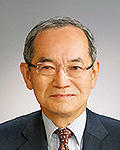Messages from Keidanren Executives and Contributed articles to Keidanren Journals May, 2018 Consumption as a Tangible Reality

Japan's current period of economic recovery is the second longest since the end of World War II. According to the Japanese government's monthly economic reports, personal consumption is also recovering, albeit modestly. Nonetheless, some say that the economic recovery still does not feel like a tangible reality.
What causes this disparity between the figures and how people actually feel? It is generally explained as being the result of only gradual economic growth, or slow growth in wages. However, I was prompted to think about the disparity from my own retail-oriented perspective.
One contributing factor could be that consumers still understand consumption as being about buying tangible goods. However much their communication costs may have increased, they still may not regard this as denoting an increase in consumption.
A second factor could be that consumer purchasing behavior has changed with the growth of the Internet, so it has become far less common to actually stand in front of goods and a salesperson and say, "I'll buy this one." With a few taps on a smartphone, commodities are delivered to a consumer's home. It seems to me that the simplicity of that process has weakened the sense that buying something is actually consumption.
The third factor could be that the figures do not match reality in the first place. Personal consumption, which accounts for 60 percent of GDP, is calculated using the Family Income and Expenditure Surveys of the Ministry of Internal Affairs and Communications, which cover 9,000 households. The figure is ultimately an estimate based on the so-called principle of equivalence of three aspects of national income, whereby the result is the same whether GDP is measured in terms of production, distributed income, or expenditure. However, rapidly increasing C2C transactions are not included in consumption, while communication costs and medical expenses are recorded as so-called intangible consumption. Consequently, the statistics do not necessarily reflect reality, and that may be the reason for the disparity compared with how people actually feel.
To achieve GDP of 600 trillion yen it will be essential to stimulate personal consumption. That will require us to take measures from a range of perspectives, including increasing disposable income and dispelling concern about the future by overhauling the social security system. The most important of all will be to boost consumer sentiment and enable the public to sense that the economy is recovering. In order to do so, whenever companies interact with consumers, they will need to precisely gauge and respond to consumer behavior as it shifts rapidly from standardization to personalization, from goods to experiences, from ownership to sharing, from real-world to online. That will allow consumption to develop into a virtuous cycle and expand, leading eventually to GDP of 600 trillion yen.
As an individual engaged on the front lines of retail, I sense that more effort is needed. I also think it is important to keep up steady promotion of the Premium Friday campaign, which has just started its second year.

